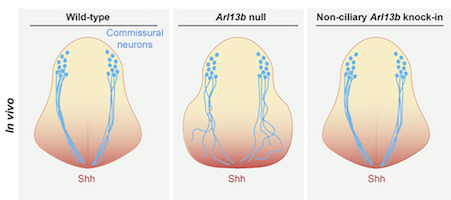Emory geneticist Tamara Caspary is an expert on the Hedgehog pathway, critical for brain development. In particular, she and her colleagues have been studying a gene that is part of the Hedgehog pathway called Arl13b, which is mutated in Joubert syndrome, affecting development of the cerebellum and brain stem.
The Arl13b protein was known to be enriched in primary cilia, tiny hair-like cellular structures with a signaling/navigation function in neuronal development. However Caspary’s lab, in a collaboration with Frederic Charron’s group in Montreal, has found that Arl13b can also function outside cilia: in axons and growth cones.
The Hedgehog pathway has several roles, some in specifying what embryonic cells will become, and others in terms of guiding growing axons, the scientists conclude in their new paper in Cell Reports.
“Arl13b regulates Shh [Sonic Hedgehog] signaling through two mechanisms: a cilia-associated one to specify cell fate and a cilia localization-independent one to guide axons,” they write. A related preprint, confirming Arl13b’s extra-ciliary role in mouse development, has been posted on bioRxiv.





